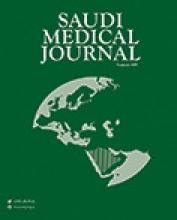Abstract
OBJECTIVE: The aim of this study is to examine the bone mineral density (BMD) in rheumatoid arthritis (RA) patients and to study the effect of disease activity and steroid therapy on BMD.
METHODS: Thirty Saudi female patients with RA and 10 Saudi healthy females matched for age as controls were the material of this work. Patients were attending the out-patient clinic of Makkah Rheumatology and Rehabilitation Center, Al-Noor Specialist Hospital, Makkah, Kingdom of Saudi Arabia between November 2002 and July 2003. All patients were subjected to clinical assessment and laboratory investigations. Bone mineral density was measured by dual-energy x-ray (DXA) in the lumbar spine at L2-4 and in the femoral bone (femoral neck, ward's triangle and trochanteric).
RESULTS: The results of our study showed a significant decrease in BMD in RA patients compared with healthy controls (spine = 0.863 +/-2.29 versus 1.289 +/- 0.54 g/cm2, p<0.05; total femoral = 0.755 +/-0.27 versus 1.06 +/-0.49 g/cm2, p<0.05; femoral neck = 0.725 +/-0.25 versus 1.008 +/-0.482 g/cm2, p<0.05; ward s triangle = 0.586 +/-0.21 versus 0.909 +/-0.43 g/cm2, p<0.05 and trochanteric = 0.607 +/-0.225 versus 0.898 +/-0.419 g/cm2, p<0.05). The decreased BMD correlated significantly with the impairment of functional activity, increased disease activity and with the use of steroids. There was no correlation between the decreased BMD and the body weight, height, age and the duration of the disease.
CONCLUSION: We conclude that the impairment functional activity, increased disease activity and the use of steroids for long periods are the major determinants of BMD of both spinal and femoral bone in rheumatoid patients.
- Copyright: © Saudi Medical Journal
This is an open-access article distributed under the terms of the Creative Commons Attribution-Noncommercial-Share Alike 3.0 Unported, which permits unrestricted use, distribution, and reproduction in any medium, provided the original work is properly cited.






